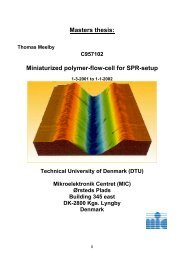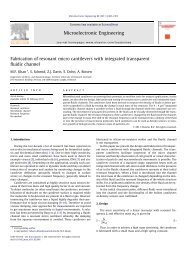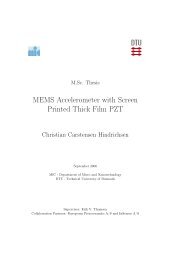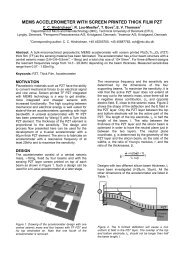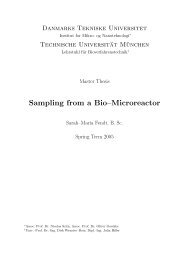Prototyping of microfluidic systems with integrated ... - DTU Nanotech
Prototyping of microfluidic systems with integrated ... - DTU Nanotech
Prototyping of microfluidic systems with integrated ... - DTU Nanotech
Create successful ePaper yourself
Turn your PDF publications into a flip-book with our unique Google optimized e-Paper software.
Chapter 3<br />
Polymer materials<br />
– mainly Topas<br />
3.1 Introduction<br />
When the concept <strong>of</strong> micro total analysis <strong>systems</strong> or µTAS was introduced<br />
by Manz et al. in 1990 [1], the predominanant materials used<br />
as substrates in the manufacturing <strong>of</strong> these <strong>systems</strong> were silicon and<br />
glass. The reason for this was the existence <strong>of</strong> well-developed methods<br />
for processing these materials, used in microelectronics. Here, methods<br />
like photolithography and wet etching <strong>of</strong> silicon and glass had been used<br />
and optimised for several decades. Several disadvantages when using<br />
these materials and methods for micr<strong>of</strong>luidic <strong>systems</strong> became, however,<br />
increasingly evident. This happened <strong>with</strong> the ongoing commercialisation<br />
<strong>of</strong> the technology, following the large number <strong>of</strong> developments and<br />
discoveries triggered by the introduction <strong>of</strong> the concept [17]. The search<br />
for alternative substrate materials for lab-on-a-chip <strong>systems</strong> lead to an<br />
increased focus on polymers because <strong>of</strong> several factors.<br />
3.1.1 Why polymers?<br />
Firstly, the cost <strong>of</strong> the silicon and glass is up to two orders <strong>of</strong> magnitude<br />
larger than the cost <strong>of</strong> substrates in polymers such as poly(methyl<br />
methacrylate)(PMMA) or polycarbonate (PC).<br />
Secondly, the many steps used in silicon processing, such as cleaning,<br />
wet and dry etching, resist coating, and lithographic structuring, are<br />
applied serially to each structure, thus increasing the fabrication time and<br />
21



